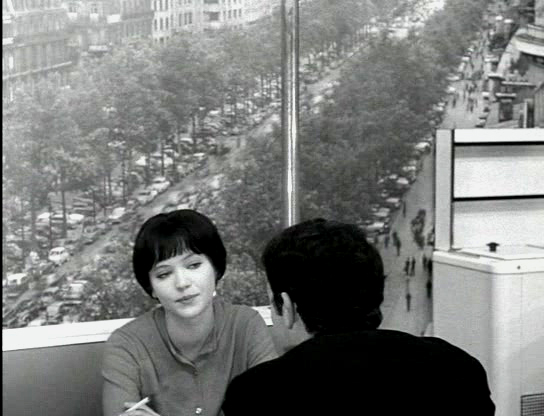
There's a wonderful tribute to Godard and Karina and their masterpiece Vivre Sa Vie on the Film Forno web site. Check it out.


There's a wonderful tribute to Godard and Karina and their masterpiece Vivre Sa Vie on the Film Forno web site. Check it out.
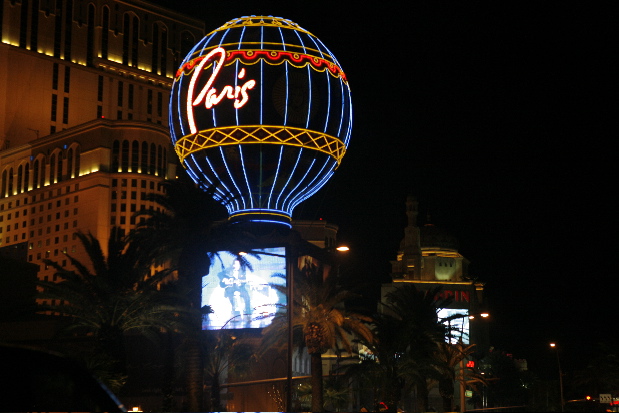
[Photo © 2007 Paul Kolnik]
In his great book The Labyrinth Of Solitude,
Ocatvio Paz remarks that “architecture is a society's unbribable
witness.” If you want to know the truth about any society, look
at what it builds.
So what is the witness of Las Vegas, the most popular tourist
destination in America? As you sit on the terrace of a French
bistro, attached to a replica of Paris, and look across the street at an
evocation of an Italian lake, or down the street at a replica of New York,
or up the street at an evocation of ancient Rome, the message is clear —
“We don't know where we are.”
Everyone in America feels this, along the strip developments and in the
malls that all look the same, whether they're in Georgia or California
— even though they might not feel it on a conscious level, or admit it to themselves.
That's why they come to Las Vegas in such great numbers, and why they
love it. Las Vegas tells us the truth, let's us admit the truth
— we don't know where we are — and the truth is always
exhilarating. It makes you want to party.
[A note to readers: I apologize
for the site's being out of commission for a while — it exceeded its
bandwidth once again, even though my hosting service allowed me double
the usage I was paying for. They finally decided that I needed to
pay them more money — that now done, the site should be functional for the
foreseeable future. Thanks for the interest!]
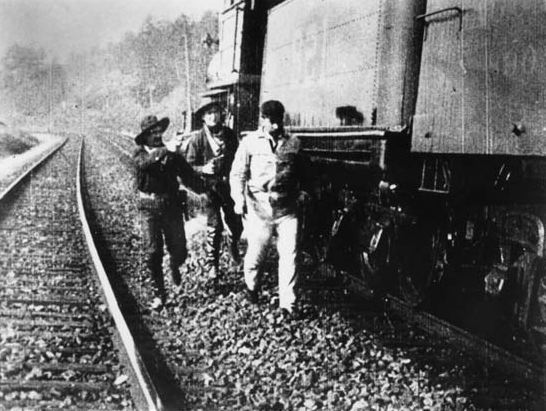
If you look at narrative films made in the first decade of the 20th
Century you'll be struck by a very odd aesthetic anomally. Scenes shot
out of doors will often be dynamically composed, emphasizing spatial
depth in the image — they look modern and can be extraordinarily
beautiful. Scenes shot on interior sets will, by contrast, be framed
head-on, creating the impression of a shallow space — this, combined
with the obviously painted sets, mostly using flats, looks decidedly
cheesy to modern eyes.
Why did audiences accept this violent contrast of cinematic practices
within the same film?
One reason, of course, is that the interior sets reminded audiences of
the stage, where painted sets and proscenium framing were familiar.
They could think of these scenes as filmed stage-plays, which is how
story-based movies were often defined and sold. The exterior scenes,
on the other hand, reminded viewers of pre-narrative cinema — the
“actualities”, short scenes of picturesque places and real events,
which were the primary content of movies presented as novelty
attractions.
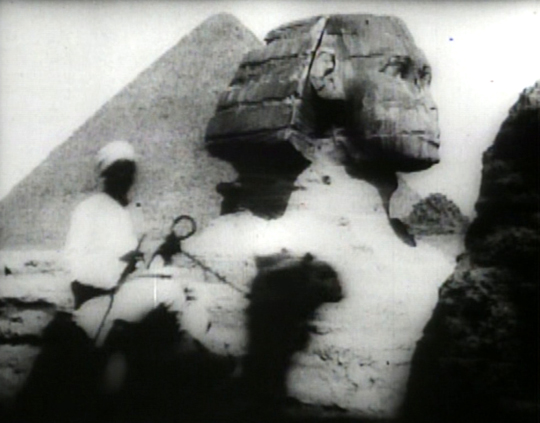
These actualities tended to be agressively “cinematic”,
emphasizing the illusion of spatial depth to show off the magic of
movies — their ability to create the convincing illusion of a real
place on the other side of the screen.
Novelty-attraction actualities were often part of a theatrical
presentation
which featured live performers as part of a variety bill — so viewers
were accustomed to an alternation of cinematic actualities with
theatrical stage-bound scenes.
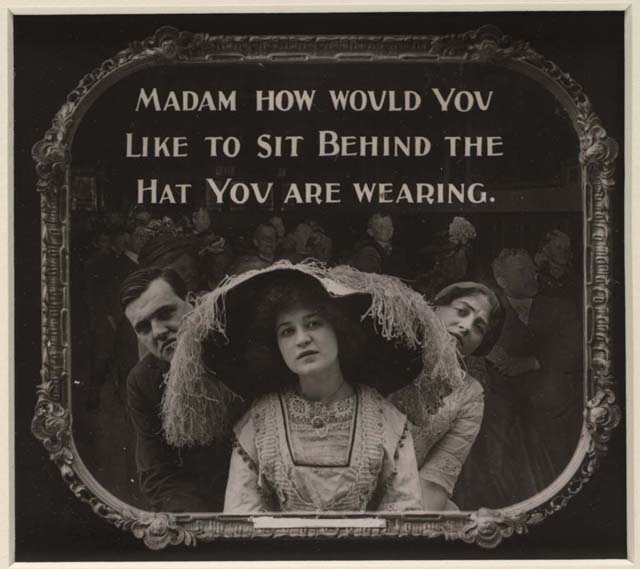
The narrative structure of early story films was apparently enough to
knit the two types of cinematic practice into an aesthetic whole for
viewers of the time. Indeed there's a curious Edison film from
around 1904, not part of the regular Edison release schedule, which
shows a
group of people making its way by various means of transport from one
end of Manhattan Island to the other. There's no connecting narrative
— the shots just seem to be a series of “actualities” linked only by
the presence of the same characters in each sequence. It's been
suggested by film scholars that these sequences may have been shot as
“entr' acts” for a stage play, showing the play's characters moving
from location to location in the story — something to pass the time
and amuse an audience while the stagehands shifted sets behind the
projected images.
If in such a production you just replaced the scenes on the stage sets
with filmed interiors, shot head-on against painted theatrical
backdrops,
you'd have a pretty fair paradigm for an early narrative film.
Even imagining how such anomalous cinematic approaches could have been
reconciled for viewers within the same film, it's hard not to see the
results as crude. But such anomalous approaches have almost always
been a part of cinematic practice — and the momentum of narrative has
always been able to reconcile them.
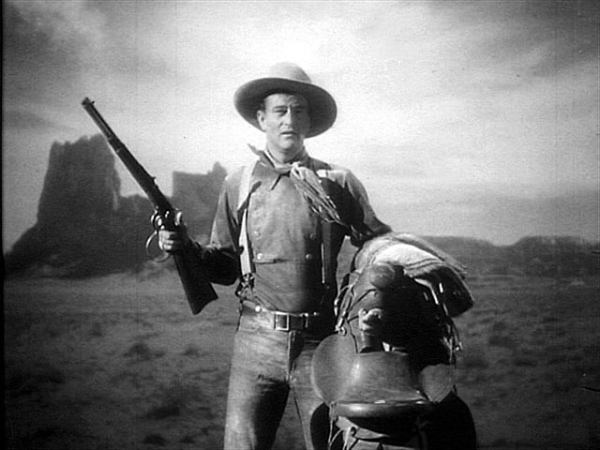
Look at John Ford's Stagecoach
again and see how stunningly photographed images of real locations
alternate with studio work (above) in which sets and back-projections stand in
for exterior locales. It's objectively weird, aesthetically
inconsistent, but our eyes, accustomed
to back-projections in films of this era, don't read it as such.
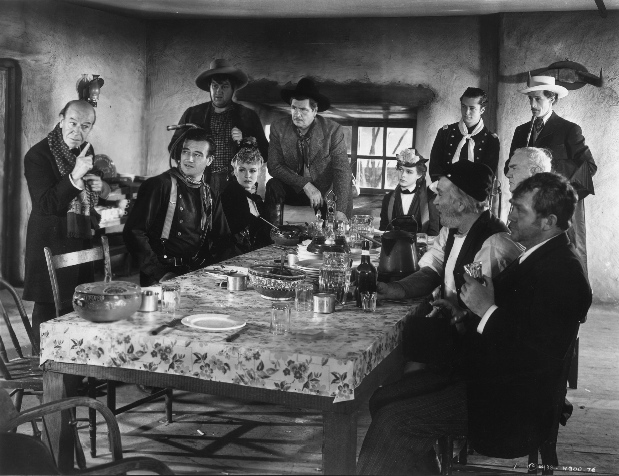
The conventions are always shifting, of course. The studio-built
interior sets of Stagecoach (above) are fully three-dimensional and
convincing as actual locations — a far cry from Edison's patently
two-dimensional interior sets painted on flats. But Ford's
back-projection exteriors are convincing only to the degree that we
choose to be
convinced by them, as Edison's audiences chose to be convinced by his
artificial interior sets.
The history of the shift from “theatrical” to fully dimensional interiors in movies would be fascinating to chart.
One of Griffith's main formal concerns in the Biograph years was
developing a way of staging and photographing interiors on sets in
spatially interesting ways, to create a stronger illusion of being in
real rooms — but he never totally abandoned proscenium framing.
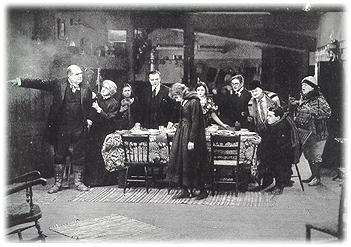
Why?
I'm beginning to think that proscenium framing for interiors continued
to have a degree of glamor for filmmakers throughout the silent era, by
evoking the prestige of the stage.
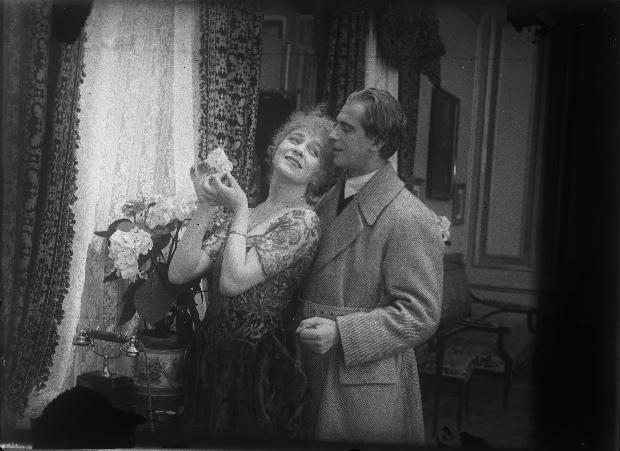
Twice in Erotikon, from
1920 (above), which has elaborately constructed and
convincing interior sets, such a set is introduced by a wide, head-on
proscenium type shot — before Stiller moves in and starts shooting the
room as though it were a practical location, sometimes even shooting in
mirrors that reflect the wall behind the camera, utterly abolishing the
theatrical mode by showing us the “fourth wall”.
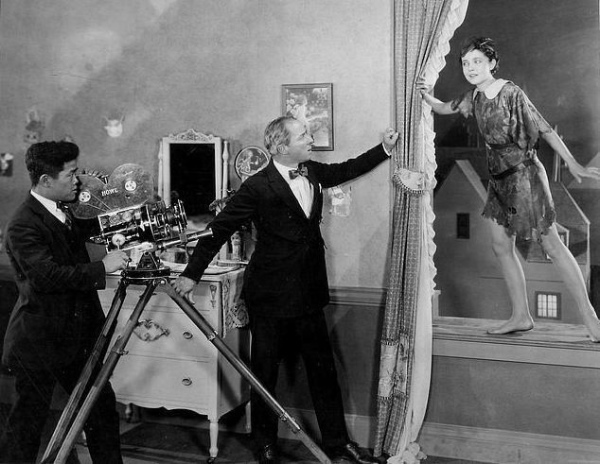
In Peter Pan, Herbert Brenon (above, with camerman James Wong Howe and Betty Bronson) does something similar with the opening sequence
in the nursery — which he starts out showing only from angles that
would have been available to members of an audience seated in front of
his set, but then proceeds to penetrate from angles only available to
performers inside the set.
Both Erotikon and Peter Pan were adaptations of popular stage
plays, and the filmmaker in each case may have wanted to remind viewers
of the film's prestigious theatrical provenance.
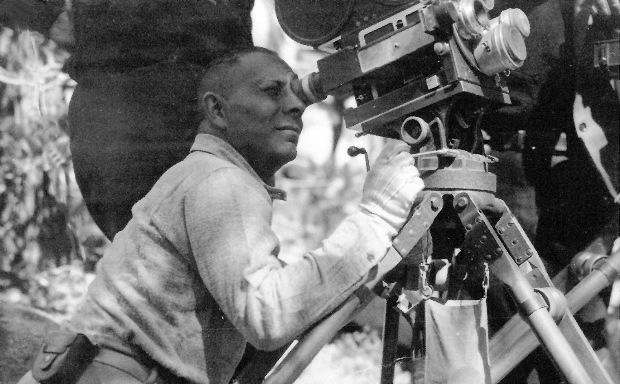
Von Stroheim seems to have been the first film artist to abolish the
theatrical mode for interiors as a matter of basic aesthetic principal,
and he was followed in this approach fairly consistently by Murnau as
well. From them derive the dynamic spatial interiors of Renoir
and Welles.
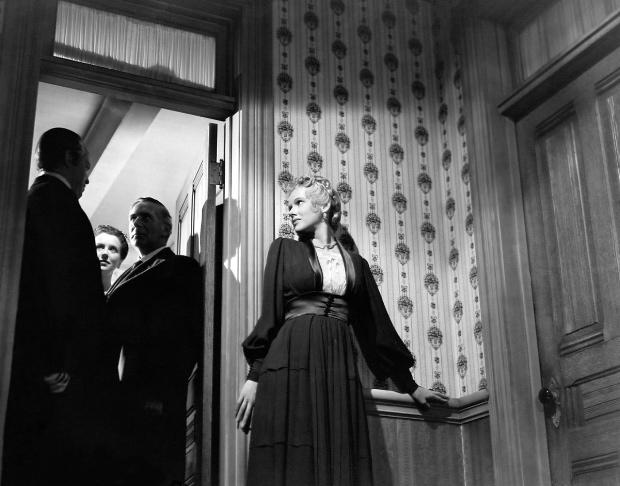
[With thanks to shahn of sixmatinis and the seventh art for a recent post which got me thinking about this subject again.]
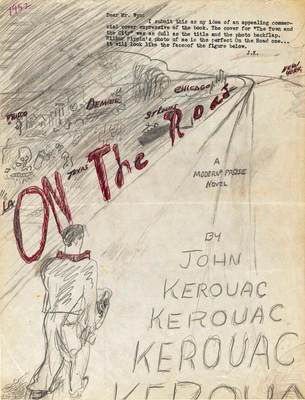
This month marks the 50th anniversary of the publication of Jack Kerouac's On the Road
and the book is getting a lot of attention. (That's Kerouac's
design for the book's cover above.) It was certainly an important
book — crystalizing the odd malaise that gripped America after WWII
and presenting an image of the way American youth would react to it, in
increasing numbers, by cutting loose from everything, drifting into a
world of sensuality and drugs, hitting the road in search of . . .
something. The book's freewheeling, lyrical prose was brilliant
enough to allow one to take it seriously as a work of art, to place it
in the picaresque tradition of Huckleberry Finn.
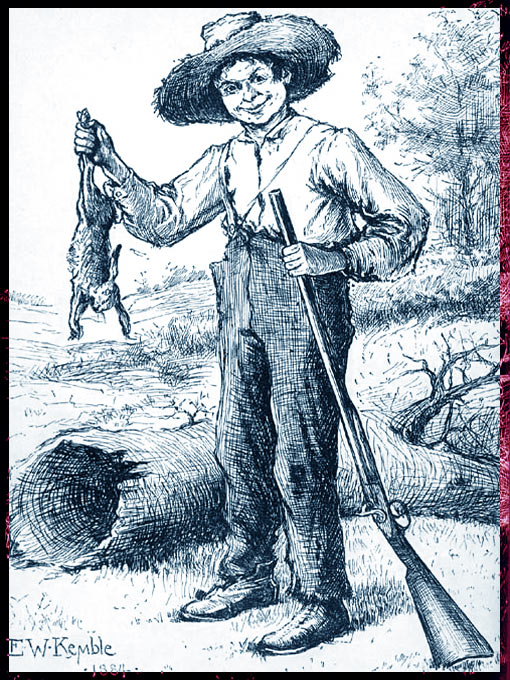
The moral and spiritual emptiness of On the Road's
protagonists was part of the
book's truth, of course, but that truth, to me, was a thin one, without
any deep humane dimensions — and this is nowhere better revealed than
in
the book's depiction of women. It's not just that Kerouac's
protagonist's treat them badly, or indifferently, but that they don't
seem to see them as human beings — and, more importantly, that the
author himself doesn't seem to see them as human beings. This is
quite a different thing from writing women characters badly,
unconvincingly — quite a different thing from ignoring women or even
raging against them for their otherness, as Henry Miller sometimes
did.
Kerouac simply seems to see women as an existential nullity.
Some women say this doesn't bother them — that the freedom
and exhilaration of the book's spirit is an inspiration to them as
women, however the women in the book are drawn. I can appreciate
the sense of that — but it doesn't lessen my revulsion at the way the
women in the book are drawn. It strikes me as revealing a basic
truth about almost all beat fiction and poetry — that once you get
past the attitude, the style, there's very little underneath it, and
what there is underneath it is often repellent.

William Burrough's magical, fractured prose, best appreciated in his
recorded readings of it, is invigorating and exciting — but a little
of it goes a long way. It's like a jazz improvisation on a melody
that the musician has forgotten, or never knew in the first
place. It's a gesture, an exercise, not an artistic creation.
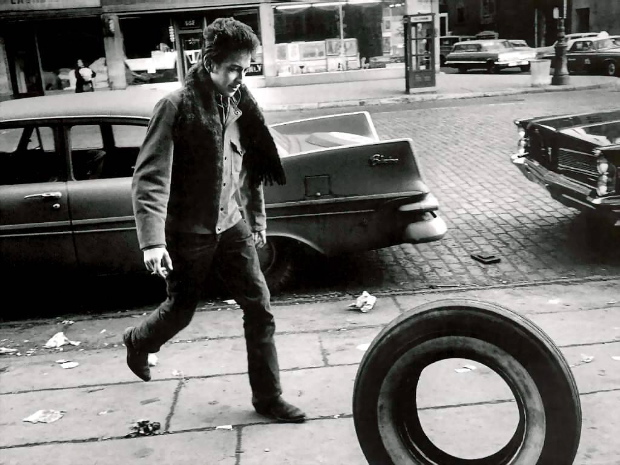
Bob Dylan was the great inheritor of the beat tradition, but he
grounded his improvisations firmly in the blues and folk traditions —
he was engaged, with a great deal of humility, in a conversation with something beyond himself.
His early work is marred by some of the same misogyny one finds in the
beats, by images of women that alternate between goddess and destroyer,
with no convincing human presence in either.
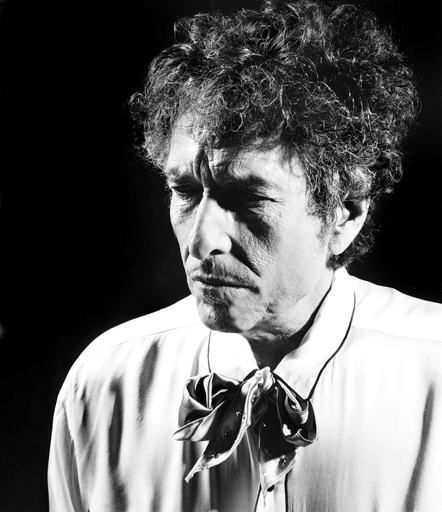
But Dylan, unlike the beats, grew as an artist. He listened to
the culture around him, its roots and moods, and talked back to
it. His work wasn't just an interior howl, a negation — he was a
rolling stone who could step outside of himself and watch himself roll.
When Kerouac tried that he was appalled by what he saw — or didn't
see. He ended his life drunk, stoned, in a state of utter decay and
despair. We can see the roots of that in On the Road. Kierkegaard said that the precise quality of despair is that it is unaware of itself. On the Road
is a harrowing portrait of a despair that is unaware of itself — one
its author shared, unawares, with the book's protagonists.

Kerouac's defenders say that only the work matters — not the
life. But I say that with Kerouac the life is in the work — is
not
transcended in the work. Which is not to say that the book isn't an
extraordinary thing, with passages of true greatness, depictions of
places and moods that are indelible, an authentic and often moving
voice with it's its own kind of feckless grandeur. It's just to say that there's something missing from it —
some element of heart and soul and sympathy that is crucial to any great work of art.

In his fascinating novel Little, Big, John Crowley proposes the idea that time does not actually elapse between
Christmases — that at Christmas we simply flip into another time frame
in which it is always Christmas and always will be. Then we flip
out of it again.
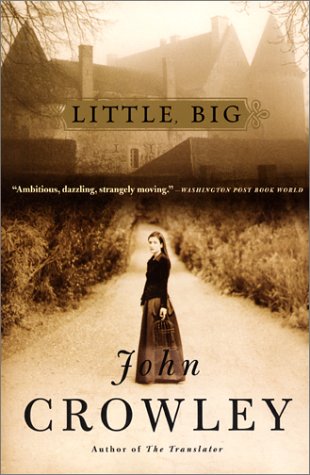
This is certainly how Christmas feels, and it ties in with some ideas Octavio Paz proposes in The Labyrinth Of Solitude, his great meditation on Mexican history and the Mexican character.
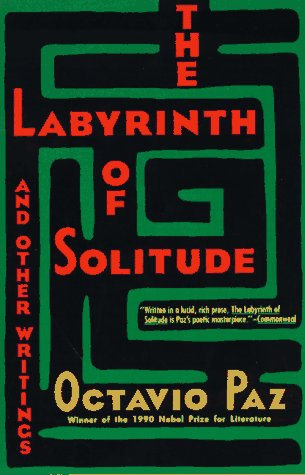
In the book, Paz discusses the importance of the fiesta
in Mexican life, as a time when Mexicans cast off their masks, the
barriers they erect against any penetration of their characteristic
solitude, and feel free to commune with others, sometimes socially,
sometimes erotically, sometimes violently.
Paz suggests that fiestas, and
all ritual celebrations, don't commemorate an event but recreate it —
recreate a transcendent moment when time is dissolved and masks are
discarded. This of course ties in with the theological
proposition that Jesus is actually present in the wine and the host at
Christian communion services — and more broadly with Kierkegaard's notion that
Christian believers are literally contemporaries of Christ.
And of course it explains why time does not pass between Christmases.

The cuba libre,
rum and Coke, always seemed like a pop cocktail to me. I guess I
associated it with early drinking in college, when it was the only
mixed drink anyone knew how to make and seemed like a painless way
to ingest a lot of alcohol.
But that was before I tried Ernest Hemingway's recipe for a cuba libre,
which is something else again. The key to this recipe is getting
hold of a Mexican Coke, which is still made with sugar, as it was in
Hemingway's day. You want to taste the rum and its parent
cane sugar all at once. (If you can't find Mexican Coke, forget I ever mentioned the cuba libre — corn syrup has no place in it.)
Squeeze half a lime into a cocktail glass. Pour in a jigger of
Bacardi white rum, add the remains of the squeezed lime and plenty of
ice and pour the Coke over it.
The result is not too sweet and not too sour and it has an exhilarating
freshness. After a couple of these you'll be imagining
you're on a tropical beach somewhere . . . and after a few more you'll
be
convinced you really are on a tropical beach somewhere.
At that point, just relax and listen to the sounds of the surf and the wind rustling the palm fronds.

Above
are the fish we took away from our fishing expedition on the Mar de
Cortés — all good for eating. We ate some of the catch in La Paz before
we left, the rest made it, frozen, to Las Vegas and Los Angeles, where
it served for a couple more wonderful meals.

We caught other fish on our expedition — including a few bonito, all
but one of which was thrown back. The biggest of them was saved to
serve as shark bait for a friend of our captain. We caught
several needlefish — nasty looking things with long pointed snouts
which are no good for eating. “Banditos” our captain called them,
disdainfully, because they steal bait. If one got hooked, the
captain had to beat it senseless with a wooden club before he removed the hook, to avoid
having his hands lacerated by the needlefish's sharp teeth.
Nora watched this procedure with burning eyes. “I almost can't
stand to look,” she said. “But it's also kind of exciting.” This struck me as a very Spanish response, with the
appeal of the bullfight in it.
In any fishing tale there's always the part about the one that got away.
Just before we headed back to shore, with our bait almost used up, I
hooked a huge fish. It felt like the big bonito I'd caught
earlier — maybe heavier. It kept wanting to sound and came up
slowly, when I could move it towards the boat, like a massive lead weight at the end of the line. When I got it to
within four or five feet of the surface we could see, in the dappled sunlight rippling through the water, that it was a gigantic
yellowfin tuna. The captain was very excited — this was
a stupendous fish. I was too excited. I jerked the line a
little too hard and the hook slipped out and I watched the amazing
thing swim away again into the depths. I was sad but also oddly
moved by the encounter.
Below, pelicans feed on the remains of our fish, after the captain had filleted them:
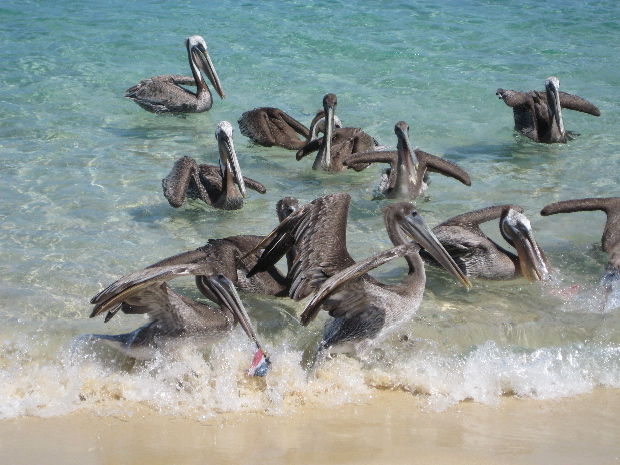
After I dropped our catch off at the restaurant at the Los Arcos I went
up to the bar for a beer. I was exhausted from the long drive to
and from the beach and the hours out on the water, all on far too
little sleep. But my nerves were singing. I knew I had
experienced something extraordinary. There was no way I could go
to sleep.
That's the moment I come back to when I think about Baja California —
the way the cold beer tasted, and the image that kept going through my
mind of the big tuna swimming away into the Mar de Cortés, its
silver sides and yellow fins flashing a few times before it disappeared
into the deep blue.
Part of my heart went with it, and is still there — lost at sea.
For previous Baja California trip reports, go here.
[Photos © 2007 Harry Rossi]

The horror! The horror!

I recently came upon a term, “risk homeostasis”, which I think helps explain why driving in Mexico feels safer, and may in fact be safer, than driving in the U. S.
Roads and streets in Mexico tend not to be as well-maintained as they are in the States, lanes tend not to be as well marked (or respected when they are marked), traffic signs are treated very casually — in La Paz, many stop signs are completely obscured by foliage. (You quickly learn to come to a full stop at every bushy tree near the corner of an intersection.)
The result is that Mexicans are forced to drive with greater care, greater attention to the behavior and greater respect for the prerogatives of other drivers — not to mention pedestrians . . . and goats.
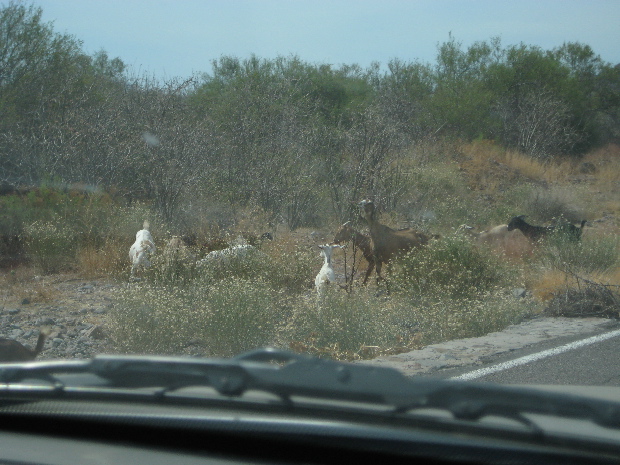
In the States, where road and street surfaces tend to be impeccable, lanes are clearly marked, traffic signs prominent and logically placed, livestock properly penned, people rely on these things to allow them to drive more carelessly — while talking on a cell phone, for example, with very little attention given to immediate traffic conditions around the vehicle. They assume that the markings and the rules will keep them out of accidents — but based on that assumption they feel free to expose themselves more to the hazards of unpredictable incidents.
This is “risk homeostasis”, a phenomenon observed in all security systems — people “consume” improvements in security and use them to justify taking more risks.

The result can be paradoxical. Here in the U. S., more pedestrians are killed in clearly marked crosswalks than in unmarked crosswalks — the bright white solid lines give them a false sense of security and lessen their attention to the actual behavior of drivers. (The GPS system in my car, above, has no detailed map data for Mexico — it only told me roughly where I was on the Baja California peninsula . . . all the rest I had to figure out for myself.)
My sister was terrified by the idea of driving in Mexico — because it all looked so anarchic. But it wasn’t anarchic at all — just the opposite. Almost all drivers were following one basic rule, which transcended all the other less basic rules — pay close attention to what your fellow drivers are doing and don’t run into them.
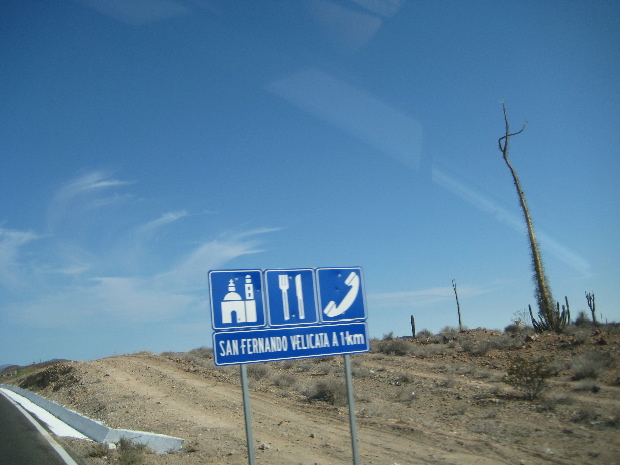
It’s the one basic rule that no improvements in traffic systems can
promote, and that many improvements in traffic systems can actually
undermine. It’s against the law in Mexico to drive while talking on a
cell phone — but it’s something you wouldn’t be likely to do anyway.
You wouldn’t feel safe. You may feel safe driving while talking on a
cell phone in the U. S., but you very likely aren’t.
By directing so much of your attention away from the traffic around
you, you have essentially “consumed” the advantages the U. S. road
system has over the Mexican road system.
For previous Baja California trip reports, go here.
[Photos © 2007 Harry Rossi]
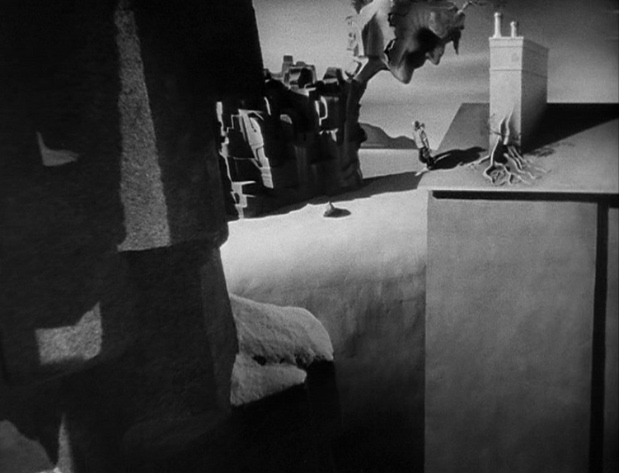
When
we think of dreamlike films, or dream sequences within films, we
inevitably think of the expressionistic style filmmakers often use
to signal a dream state — but of course real dreams do not present
themselves in that way. We might, in a dream, find ourselves at home
and discover a previously unnoticed door opening onto a previously
unsuspected wing of the house — but that wing is not appointed like
the cabinet of Dr. Caligari . . . it is as convincingly real a place,
in the dream, as the actual house we know.
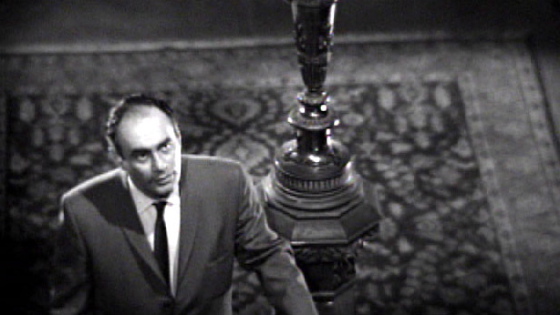
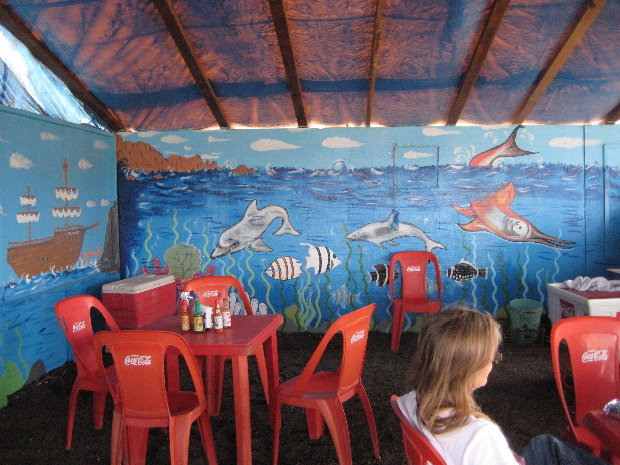
One
of the sweetest aspects of traveling in Mexico is experiencing a
society that has not been thoroughly corporatized. Big U. S.
corporations have infected Mexico on a large scale, but you only see
the manifestation of this in localized areas of big cities — the strip
developments on the outskirts of towns where Wal-Mart and Office Depot
rule. There's a Burger King and an Applebee's on the malecón in La Paz, but they still seem anomalous, like unsightly trash dumps in a vacant lot.
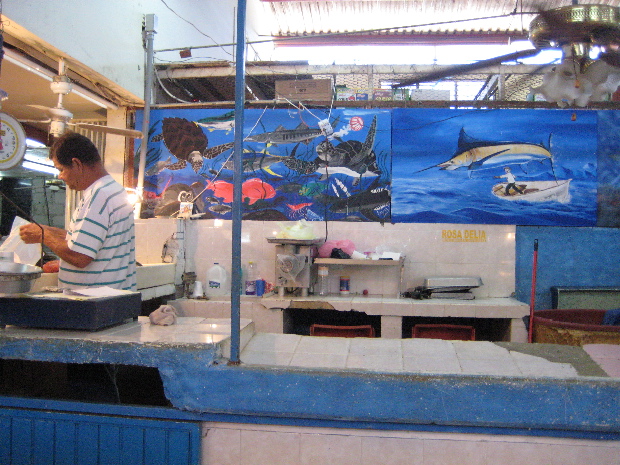
Everywhere else, businesses seem to be run by, stamped
with the personality of, actual human beings. Restaurants and taco stands
are decorated according to the eccentric tastes of the
proprietors. You visit them not to find some standardized form of
service and decor, originating in some distant corporate headquarters,
but to have the adventure of meeting and interacting with the individuals who have personally organized these enterprises.

Las Vegas knows the advantage of this sort of eccentricity —
restaurants here, like casinos, have quirky themes, promise to be
“experiences” . . . but it's all professionally designed, the product
of artful concepts rather than of individual obsessions or
passions. It's better than nothing but it's a far cry from the
organic expressiveness of everyday Mexican culture.
For previous Baja California trip reports, go here.
[Photos © 2007 Harry Rossi]
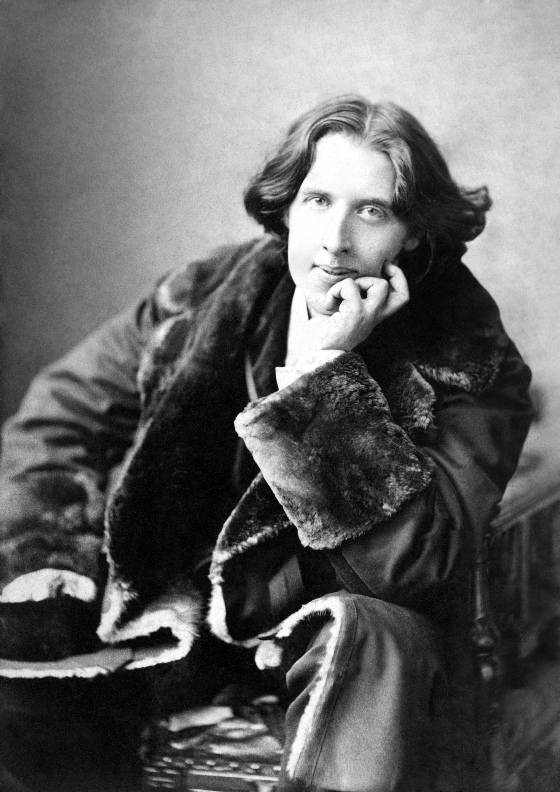
While the ultimate virtue in Wilde’s essays is in make-believe, the
denouement of his dramas and narratives is that masks have to go.
We must acknowledge what we are. Wilde at least was keen to do
so. Though he offered himself as the apostle of pleasure, his
created world contains much pain. In the smashup of his fortunes
rather than in their apogee his cast of mind fully appeared . . .
Essentially Wilde was conducting, in the most
civilized way, an anatomy of his society, and a radical reconsideration
of its ethics. He knew all the secrets and could expose all the
pretense. Along with Blake and Nietzsche he was proposing that
good and evil are not what they seem, that moral tabs cannot cope with
the complexity of behavior. His greatness as a writer is partly
the result of the enlargement of sympathy which he demanded for
society’s victims . . .
As for his wit, its balance was more hazardously maintained than is
realized. Although it lays claim to arrogance, it seeks to please
us. Of all writers, Wilde was perhaps the best company.
Always endangered, he laughs at his plight, and on his way to the loss
of everything he jollies society for being so much harsher than he is,
so much less graceful, so much less attractive. And once we
recognize that his charm is threatened, its eye on the door left open
for the witless law, it becomes even more beguiling . . .
He occupied, as he insisted, a “symbolical relation” to his time.
He ranged over the visible and invisible worlds, and dominated them by
his unusual views. He is not one of those writers who as the
centuries change lose their relevance. Wilde is one of us.
His wit is an agent of renewal, as pertinent now as a hundred years
ago. The questions posed by both his art and his life lend his
art a quality of earnestness, an earnestness which he always disavowed.
— Richard
Ellman
from his
biography Oscar Wilde
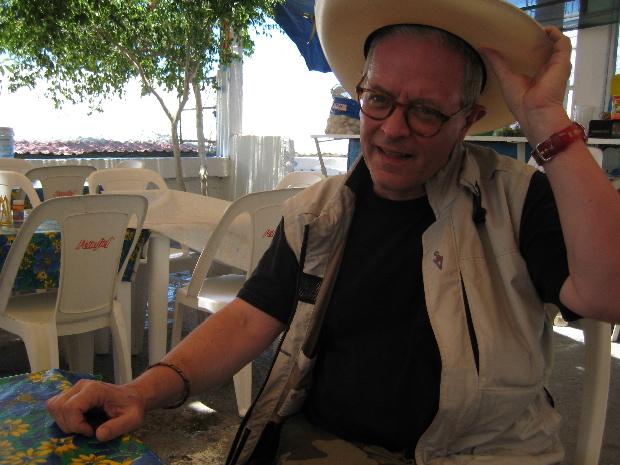
In Mexico, when
referring to the U. S. State of California, don't call it California,
call it Alta California, thus showing that you realize there are three
Californias — the U. S. state and the two Mexican states, Baja
California and Baja California Sur. Mexicans are so unaccustomed
to gringos using the term Alta California that they will sometime laugh
when they hear it, but it's a laugh of satisfaction and approval.
I'm sure I don't have to encourage anyone not to refer to Cabo San Lucas as “Cabo”, but by the same token, don't refer to Baja California as Baja. Baja
just means “lower”. It's sort of like saying, “I'm going to
North,” when what you mean is, “I'm going to North Dakota.”
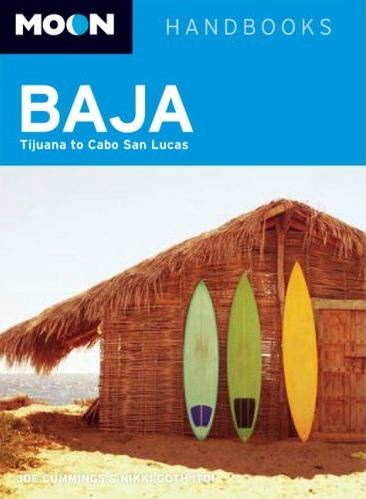
In spite of the above, get hold of a copy Baja in the Moon Handbooks series. It offered the most sensible advice about traveling in Baja California and the most reliable
recommendations about hotels and restaurants. We carried the
2004 edition, which was already outdated in some respects, but there's
a new edition coming out this month (see above.) Also, be sure to
carry the AAA road map of Baja California, the best one available north
of the line.
Take along some chewable Pepto Bismol tablets. These handled all
the (very mild) stomach upsets we suffered in Mexico. Take along
some Benadryl, in case of wasp and bee stings. In the desert
environment of Baja California, bees and wasps will appear out of
nowhere, in the midst of the most barren wasteland, if you expose so
much as cookie crumb, or open a container of anything liquid. If
you keep items made with sugar wrapped and stuff tissue paper into the
tops of open soda or beer containers, they vanish just as quickly.

But accidents can happen. On our fishing expedition, a fellow
passenger in our van popped open a beer when she got back to the beach
after her time on the water. Within about two sips, and without
her realizing it, a bee got into the bottle. She swallowed it and
it stung the inside of her throat on the way down. We were at
least an hour away from any kind of medical facility, and if my sister
hadn't had some liquid Benadryl in her fanny pack, the situation could
have been dangerous. As it was the Benadryl reduced the swelling
in the woman's throat, allowing her to breathe freely, and some Advil
(which my sister was also carrying) helped her manage the excruciating
pain
I have no idea why my sister was carrying Benadryl in her fanny pack —
just as a general precaution, she claimed, though I suspect that
Nuestra Señora de Guadalupe put the idea into her head precisely for
the emergency in question.
This brings me to my final tip — always listen to the promptings of La Morenita. She will never steer you wrong.
For previous Baja California trip reports, go here.
[Photos © 2007 Harry Rossi]

World War Two was a “good war”. America and its allies pulled together
and destroyed the Axis powers. On balance, and in retrospect, it
has to be considered one of the great achievements of
humane civilization. But human beings don’t live on balance or in
retrospect, particularly where war is concerned. They live inside
the horror of it and it takes a toll on individuals and on societies
which can never be fully measured.
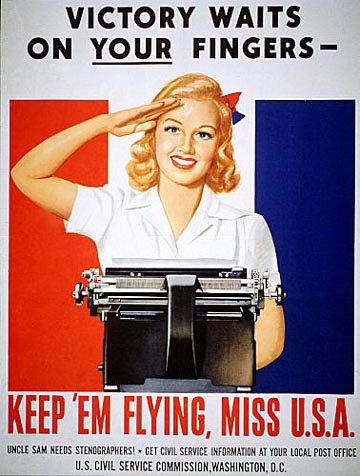
The upbeat spirit of American propaganda during the war, and the
genuine satisfactions of victory, veiled the true experience of the war
for millions — not just for those who fought it on the battlefields of the
world, but for those at home who lived in terror that their loved ones at
the front might never return . . . and of course, most especially, for those at home whose loved ones didn’t return. On a broader level, anyone who simply witnessed
the spectacle of total war on a global scale, from whatever distance, had
to have experienced a soul-shaking anxiety about the fragility of all
social structures and cultural norms.
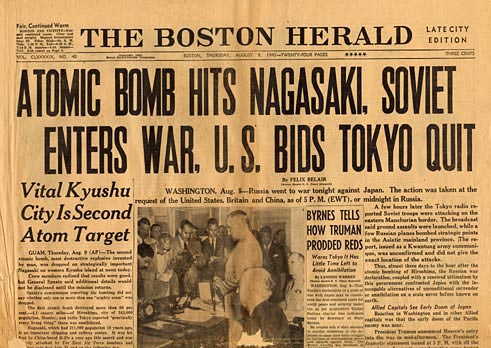
After WWII, the whole planet experienced post-traumatic stress disorder
— localized in this case by the fact of the atomic bomb, which ended
the war but left the world with a paradox that wouldn’t go away.
It took an act of colossal horror to finally “win” this good
war. And the prospect of this horror being again visited on the
world was far from unimaginable.

We now know a lot more than we used to about post-traumatic stress
disorder and the ways it can be treated. In the immediate post-war era, the
phenomenon was more elusive, and often unrecognized. We made
meaningful social restitution to the veterans of the war, with measures like
the G. I. Bill — we reconstructed the devastated nations we
conquered. But that just scratched the surface.
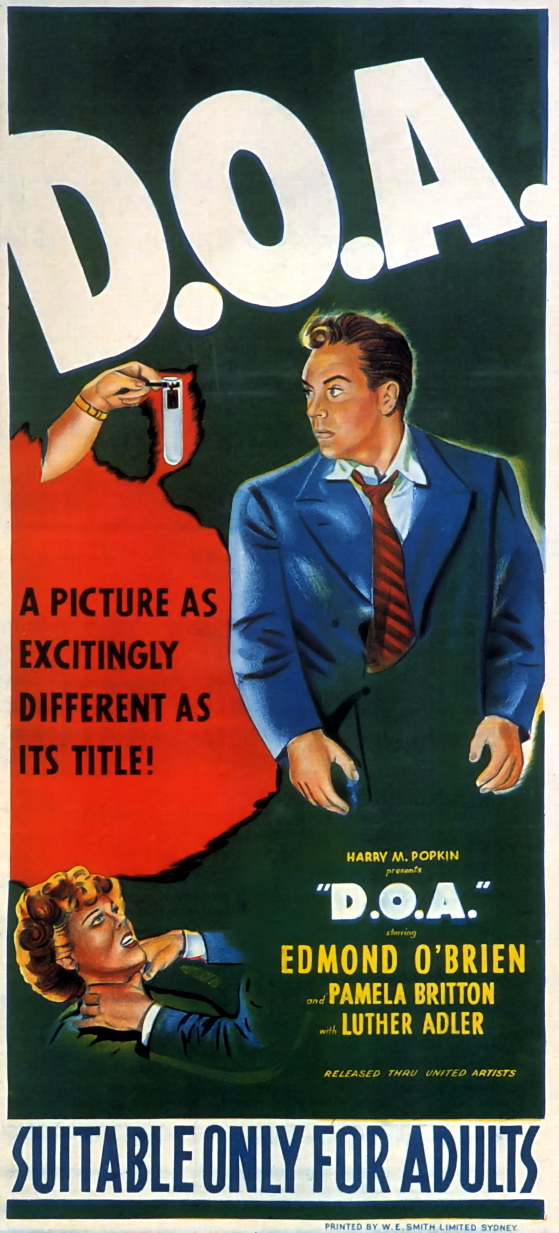
It was in art that the true psychic cost of the war was exposed and explored — nowhere more pointedly than in film noir. The sort of trauma that engenders PTSD is identifiable by several characteristics — a sense of being out of control and confused, a
sense of terror, a sense of being outside the normal realm of human
experience. Is there a better description of the usual
predicament of the protagonist in a classic film noir?
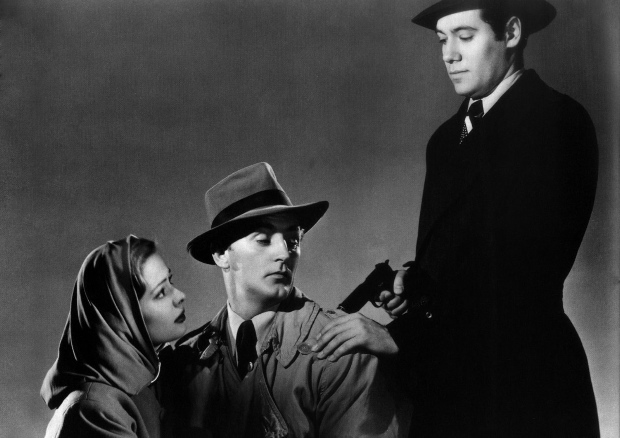
PTSD on a broad cultural and societal level is what best explains the phenomenon of film noir, which on its surface is so mysterious. Why should a triumphant
nation, after a great collective victory in a good war, have been
gripped by that mood of existential dread which informs so many Hollywood films of the post-war era? Why should the most spectacular achievement of American arms have led
to a crisis of manhood, a sense of impotence, a fear of powerful women
incarnated in the morbid fantasy of the femme fatale?

Film noir was a dream landscape where the buried costs of WWII could be recognized, reckoned and mourned, as a prelude to psychic recovery, or at least psychic survival.
Veterans of combat often report the difficulty of dealing with people
who have not shared their experience of it — people who can never
really know what it’s like. Film noir, far more than the WWII combat film, was one of the few arenas of American life where the true legacies of war, its lingering moral and
psychological dislocations, could be engaged without apology or shame.
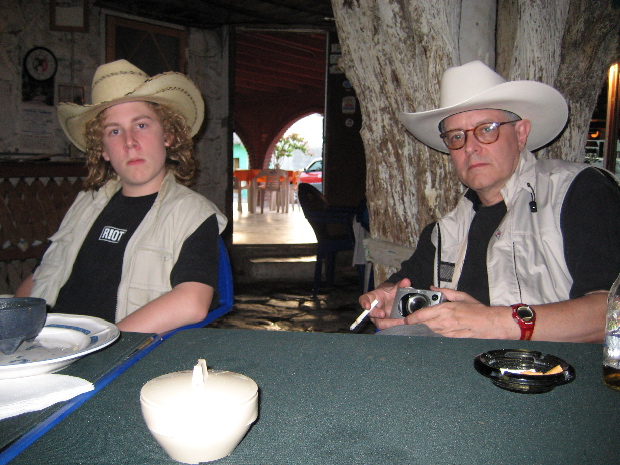
First
tip — if you’re a guy, wear a straw cowboy hat. I don’t pretend
to understand the full cultural significance of the straw cowboy hat in
Mexico, but I do know that it has replaced the sombrero as the national
headgear, though it’s not nearly as ubiquitous as the sombrero used to
be. The sombrero has become ceremonial, part of a costume used on
festive occasions and by theatrical mariachi troupes. The bands
of strolling musicians who play in restaurants, for example, wear straw
cowboy hats.
Hip young kids in Mexico don’t wear straw cowboy hats, nor do
sophisticated professionals, and the baseball cap is making strong
inroads everywhere, even in rural areas.
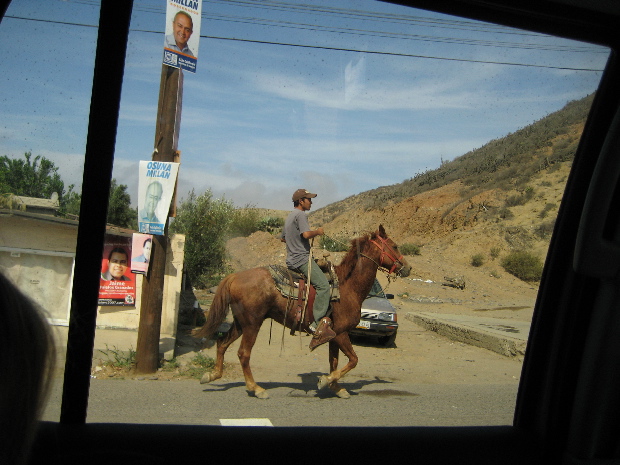
The straw cowboy hat
seems to have something of the significance of the cowboy hat in
America, a sign of solidarity with the nation’s rural roots and the
romance of the ranchero.
The important thing is that Yankee tourists don’t usually wear straw
cowboy hats. My three traveling companions, all blond, were
usually taken at once as Yankees, but people sometimes expressed
surprise to find that I wasn’t Mexican. Even when I was taken as
a gringo, the hat seemed to confer on me the benefit of the doubt,
especially at the ubiquitous army checkpoints where they stop your car
to look for drugs. (They have stepped these up recently at the
urging of the U. S. government, so don’t blame Mexico for the resulting
inconvenience.) We were usually ushered through these with
only the most cursory of inspections, while other gringos were being
searched rigorously. I attribute this to the formal and
respectful greetings I offered to the soldiers — and to the hat.
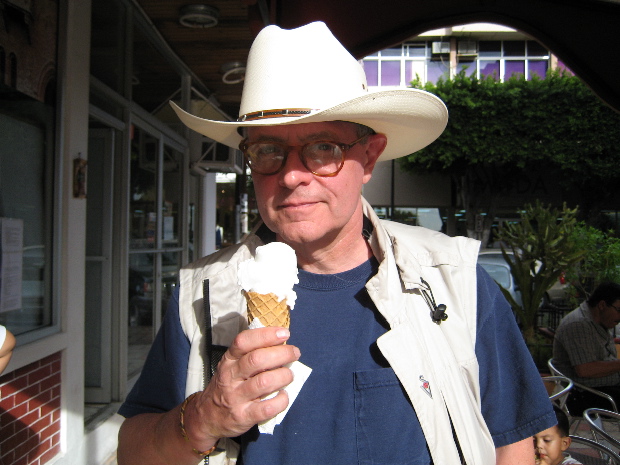
I live in a U. S. state that still considers itself Western.
Wearing a cowboy hat in Las Vegas doesn’t arouse any special curiosity
outside of the fancy casinos or yuppie enclaves like Summerlin . . . so
I didn’t feel that wearing one in Mexico constituted any kind of
charade. The hat seems to mean more or less the same thing on
both sides of the border. Maybe that’s the point.
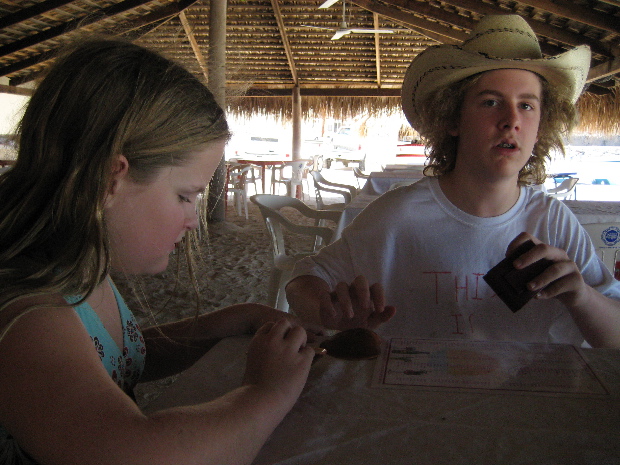
Second tip — travel with kids. Mexicans have an instinctive
reaction to kids that instantly dissolves all linguistic and
cultural barriers. They like having them around. They like
you for bringing them around.
Third tip — avoid the Pacific coast of Baja California above
Ensenada. Even if you’re motoring down from San Diego, go east
and cross at Tecate. The Pacific coast above Ensenada offers a
vision of the future of Baja California, as more and more Yankees
retire or build vacation homes there. The vision will make you
ashamed of being a Yankee and depressed about the future of Baja
California.
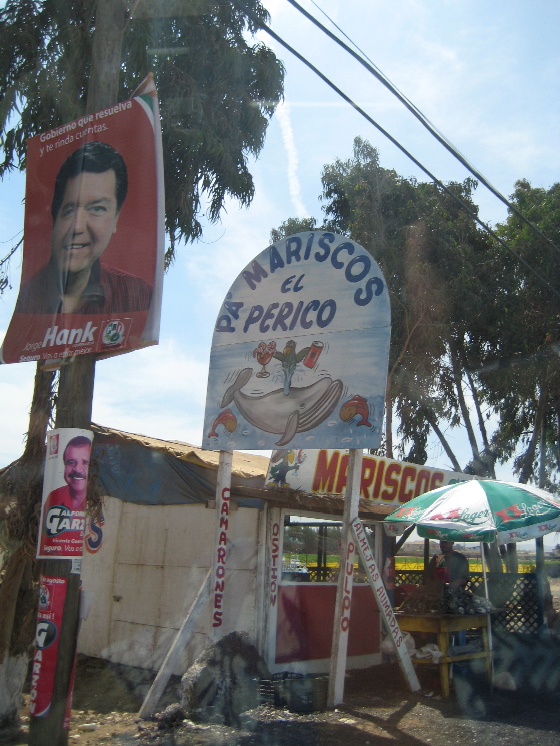
Fourth tip — go! Just go. Below Ensenada, and outside the
city limits of Cabo San Lucas, Mexico is still there. Its
gracious and humane culture has much to teach and many ways of
enchanting its complacent neighbors north of the border.
For previous Baja California trip reports, go here.
[Photos © 2007 Harry Rossi]